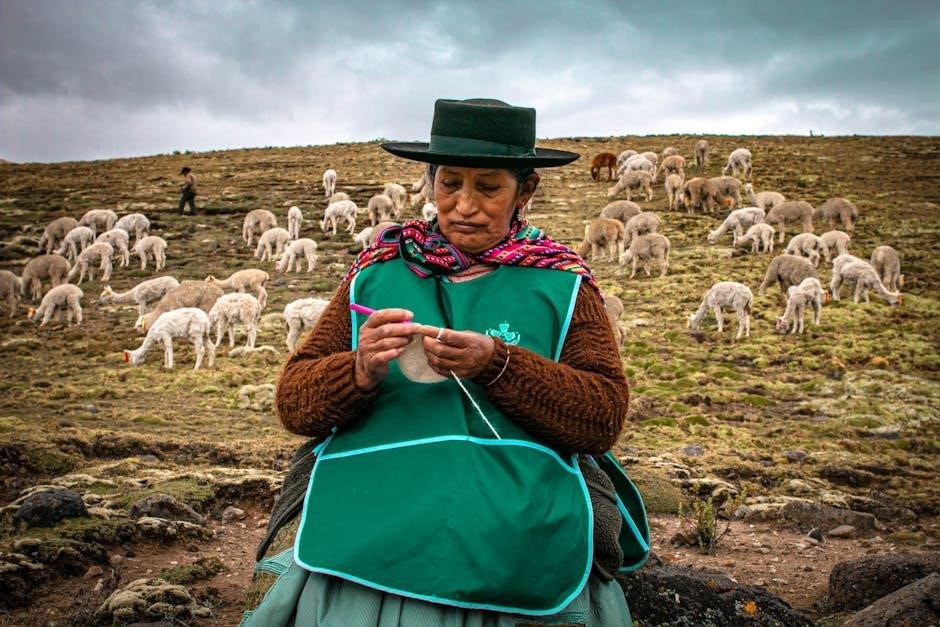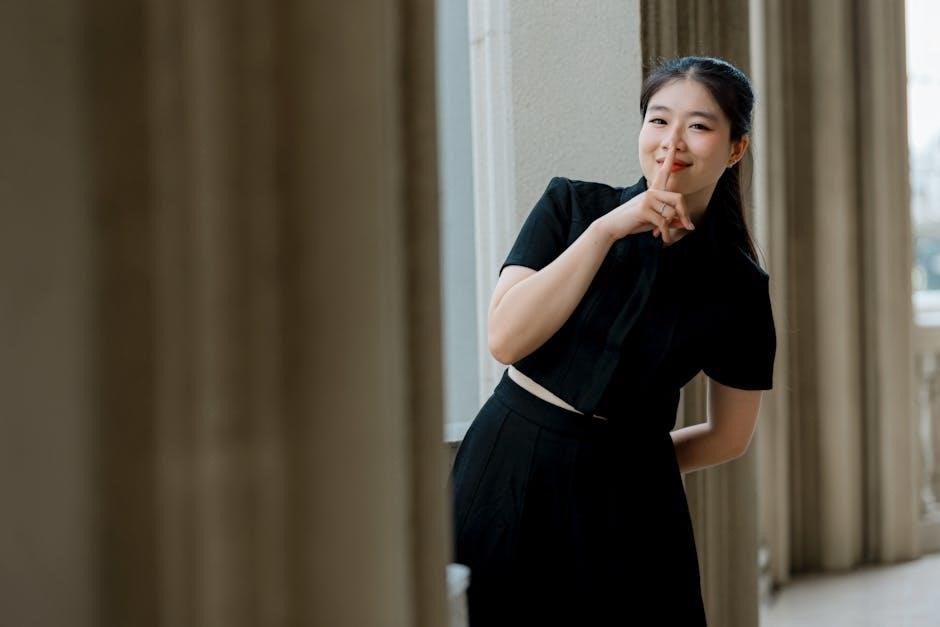The Mason-Dixon Field Guide to Knitting PDF is a comprehensive resource by Maggie Righetti, offering detailed techniques and patterns for all skill levels in a convenient digital format.
1.1 Overview of the Guide
The Mason-Dixon Field Guide to Knitting PDF is a detailed and comprehensive resource designed for knitters of all skill levels. Written by renowned expert Maggie Righetti, it offers clear instructions, illustrations, and tips to master various knitting techniques. The guide covers basic stitches, advanced methods, and a wide range of patterns for garments, accessories, and home decor. Its organized structure ensures easy navigation, making it a valuable tool for both beginners and experienced knitters seeking to enhance their skills and creativity.
1.2 Importance of the Guide in Knitting
The Mason-Dixon Field Guide to Knitting PDF is a cornerstone for knitters, bridging the gap between basic and advanced techniques. Its clear instructions and comprehensive coverage make it indispensable for skill development. The guide enhances creativity and precision, offering a wide range of patterns and tips. It serves as a trusted reference, fostering confidence in knitters of all levels. By providing accessible and detailed guidance, the guide has become a vital tool for mastering knitting, making it a must-have for every knitting enthusiast.
1.3 Brief History of the Guide
The Mason-Dixon Field Guide to Knitting PDF was created by renowned knitting experts, including Maggie Righetti, Ann Shayne, and Kay Gardiner. Initially part of a series, it evolved into a standalone resource, offering detailed instructions and patterns. The guide gained popularity for its clarity and accessibility, becoming a trusted tool for knitters worldwide. Its origins trace back to the Mason-Dixon Knitting blog, which inspired the creation of this comprehensive guide. Over time, it has grown into a beloved resource, blending tradition with modern techniques.

Authors Behind the Mason-Dixon Field Guide
The guide is authored by Maggie Righetti, a renowned knitting expert, along with Ann Shayne and Kay Gardiner, known for their creative and practical knitting insights.
2.1 Maggie Righetti: The Renowned Knitting Expert
Maggie Righetti is a celebrated knitting expert and author of the Mason-Dixon Field Guide to Knitting. Known for her clear, concise writing, she simplifies complex techniques, making them accessible to all skill levels. With extensive experience in knitting education, Righetti has written numerous books and articles, solidifying her reputation as a trusted authority. Her work in the guide covers basic stitches to advanced methods, ensuring it’s a timeless resource for knitters worldwide.
2.2 Contributions of Ann Shayne and Kay Gardiner
Ann Shayne and Kay Gardiner, the dynamic duo behind Mason-Dixon Knitting, bring creativity and practicality to the field. Their guides blend humor with expertise, offering patterns and tips for all skill levels. As founders of Modern Daily Knitting, they inspire a global community, making knitting accessible and enjoyable. Their contributions include innovative designs and a user-friendly approach, ensuring the guide remains a beloved resource for knitters seeking both inspiration and technical guidance.
2.3 Their Impact on the Knitting Community
Ann Shayne and Kay Gardiner have profoundly influenced the knitting community through their Mason-Dixon Field Guides. Their engaging approach and innovative patterns have inspired countless knitters worldwide. By fostering a sense of camaraderie and creativity, they’ve built a vibrant community. Their guides are celebrated for their clarity and accessibility, making complex techniques approachable. This has not only elevated individual skills but also strengthened the global knitting network, ensuring their legacy as pivotal figures in the craft.

Structure and Organization of the Guide
The Mason-Dixon Field Guide to Knitting PDF is meticulously organized into clear sections, ensuring easy navigation. Its user-friendly layout and logical flow make it accessible for knitters of all levels.
3.1 Main Sections of the Guide
The Mason-Dixon Field Guide to Knitting PDF is divided into well-defined sections, including basic stitches, advanced techniques, and patterns for garments, accessories, and home decor. It also features a yarn guide, needle size charts, and tips for project success. Each section is designed to cater to all skill levels, ensuring a smooth learning curve for beginners while offering challenges for experienced knitters. The guide’s logical structure makes it easy to navigate, allowing users to find specific techniques or patterns quickly and efficiently.
3.2 How the Guide is Organized for Easy Access
The Mason-Dixon Field Guide to Knitting PDF is meticulously organized to ensure easy access to information. It features clear chapter divisions, detailed tables of contents, and cross-references that link related topics. Each section builds logically on the previous one, guiding users from basic to advanced techniques. The PDF format includes bookmarks and hyperlinks, allowing quick navigation between chapters and patterns. This intuitive structure enhances the learning experience, making it simple for knitters of all levels to find and follow instructions effortlessly.
3.3 Navigating Through the PDF Version

The Mason-Dixon Field Guide to Knitting PDF is designed for seamless navigation. It features bookmarks for quick access to sections, hyperlinks to patterns, and a detailed table of contents. Users can easily search for specific techniques or patterns using the built-in search function. The PDF also allows zooming in on intricate details, making it simple to follow complex instructions. These features ensure that knitters of all levels can efficiently explore the guide and find the information they need without hassle.

Key Features of the Mason-Dixon Field Guide
The guide offers clear instructions, comprehensive techniques, and inspirational patterns, making it a versatile resource for all skill levels. Its well-organized layout ensures easy access to information.
4.1 Clarity in Instructions and Patterns
The Mason-Dixon Field Guide to Knitting PDF excels in its clear and concise instructions, making complex techniques accessible to all skill levels. Maggie Righetti’s writing style ensures that even intricate patterns, such as lace stitches, are explained with precision. The guide’s step-by-step format allows knitters to follow along effortlessly, while its detailed illustrations and charts provide visual support. This clarity makes the guide an invaluable resource for both beginners and experienced knitters, ensuring successful project outcomes and fostering confidence in their skills.
4.2 Comprehensive Coverage of Knitting Techniques
The Mason-Dixon Field Guide to Knitting PDF offers an extensive exploration of knitting techniques, from basic stitches to advanced methods like lace, cables, and colorwork. It provides detailed instructions for various projects, including garments, accessories, and home decor, ensuring a wide range of applications. The guide’s thorough coverage makes it a versatile tool for knitters, allowing them to explore different styles and expand their skills confidently. Its organized structure ensures that both beginners and experienced knitters can easily find the techniques they need to master.
4.3 Well-Organized Layout for All Skill Levels
The Mason-Dixon Field Guide to Knitting PDF features a well-organized layout designed to cater to all skill levels. Each section is clearly divided, making it easy for knitters to navigate and find specific techniques or patterns; The guide starts with basic stitches and gradually progresses to more complex projects, ensuring a smooth learning curve. This structure allows beginners to build confidence while providing experienced knitters with quick access to advanced methods, making it a universally accessible and practical resource for everyone.
4.4 Authority and Expertise in Knitting
The Mason-Dixon Field Guide to Knitting PDF is backed by the expertise of Maggie Righetti, a renowned knitting authority. Her clear, concise writing ensures complex techniques are accessible to all skill levels; The guide’s comprehensive coverage of knitting methods, from basic stitches to advanced patterns, reflects Righetti’s deep knowledge and experience. This expertise makes the guide a trusted resource, ensuring knitters can rely on its instructions and advice to produce high-quality, professional-looking projects with confidence.
4.5 Inspirational Patterns and Designs
The Mason-Dixon Field Guide to Knitting PDF features a wide array of inspirational patterns and designs, catering to diverse tastes and skill levels. From simple scarves and hats to intricate sweaters and home decor, the guide offers creative projects that spark imagination. Each pattern is accompanied by clear instructions, making it easy for knitters to bring their visions to life. The designs blend traditional techniques with modern aesthetics, ensuring endless inspiration for crafters seeking to create something unique and meaningful.

Target Audience of the Guide
The Mason-Dixon Field Guide to Knitting PDF is designed for knitters of all skill levels, offering patterns and techniques that cater to both beginners and experienced crafters alike.
5.1 Suitability for Beginners
The Mason-Dixon Field Guide to Knitting PDF is an excellent resource for beginners, offering clear instructions for basic stitches like casting on, knitting, purling, and binding off. The guide provides step-by-step patterns for simple projects such as scarves and hats, making it easy for new knitters to build confidence. Tips on selecting the right yarn and needles are included, ensuring a smooth start. The guide’s accessible format and concise explanations make it ideal for those just starting their knitting journey.
5.2 Advanced Techniques for Experienced Knitters
The Mason-Dixon Field Guide to Knitting PDF caters to experienced knitters with advanced techniques, such as intricate lace patterns, complex cables, and detailed texture work. It offers challenging projects like sweaters and afghans, perfect for refining skills. The guide’s clear instructions and expert tips ensure mastery of advanced methods, while its comprehensive coverage of knitting disciplines provides endless opportunities for creative growth and skill enhancement.
5.3 Versatility for All Skill Levels
The Mason-Dixon Field Guide to Knitting PDF seamlessly accommodates knitters of all skill levels, offering a wide range of patterns from simple scarves to complex sweaters. Beginners can start with basic stitches and projects, while experienced knitters can explore advanced techniques. The guide’s well-organized structure ensures easy navigation, making it a versatile resource that grows with the knitter’s expertise, providing endless inspiration and practical guidance for every project.

Benefits of the PDF Format
The Mason-Dixon Field Guide to Knitting PDF offers convenience, portability, and easy access on multiple devices, making it ideal for knitters on the go while being environmentally friendly.
6.1 Convenience and Portability
The Mason-Dixon Field Guide to Knitting PDF offers unparalleled convenience and portability, allowing knitters to access patterns and instructions on multiple devices like computers, tablets, and smartphones. Its digital format eliminates the need for physical storage, making it easy to carry wherever inspiration strikes. Whether at home, in a class, or on the go, the PDF ensures that essential knitting resources are always within reach, fostering creativity and productivity without compromising space or convenience.
6.2 Easy Access on Multiple Devices
The Mason-Dixon Field Guide to Knitting PDF ensures seamless access across various devices, including computers, tablets, and smartphones. This versatility allows knitters to reference patterns and techniques anytime, anywhere. Whether planning projects at home or knitting on the go, the PDF’s compatibility with multiple platforms enhances flexibility and convenience, making it an indispensable tool for knitters of all levels who value accessibility and ease of use in their creative journey.
6.4 Environmentally Friendly Option
The Mason-Dixon Field Guide to Knitting PDF offers an eco-conscious choice by eliminating the need for physical materials. As a digital resource, it reduces paper consumption and carbon footprint, appealing to environmentally aware knitters. This sustainable format aligns with modern values, providing a guilt-free way to access knitting knowledge while preserving the planet for future generations of crafters.

Tips for Using the Mason-Dixon Field Guide Effectively
Maximize your knitting experience by selecting the right yarn and needles, following instructions carefully, and practicing regularly. Don’t hesitate to seek help when needed and enjoy the creative process.
7.1 Choosing the Right Yarn and Needles
Selecting the appropriate yarn and needles is crucial for achieving the desired results in your knitting projects. The guide provides a detailed yarn guide and needle size conversion chart to help you make informed decisions. Understanding the fiber content, weight, and texture of yarn ensures your project will have the right drape and durability. Similarly, using the correct needle size is essential for maintaining the proper gauge. Always swatch before starting a project to ensure accuracy and consistency in your knitting.
7.2 Following Instructions Carefully
The guide emphasizes the importance of following instructions meticulously to ensure successful project outcomes. Maggie Righetti’s clear, step-by-step patterns are designed to guide knitters of all levels. Paying close attention to details like stitch counts, gauge, and yarn requirements is crucial. The guide’s concise writing style and visual aids, such as charts and photos, help clarify complex techniques. By carefully following the instructions, knitters can master new skills, avoid common mistakes, and achieve professional-looking results in their knitting projects.
7.3 Seeking Help When Needed
Knitting can sometimes present challenges, and seeking help is a natural part of the learning process. The guide encourages knitters to reach out to online communities, forums, or local knitting groups when stuck; Many resources, including tutorials and expert advice, are available to clarify techniques. Don’t hesitate to ask for guidance—whether it’s understanding a pattern or mastering a stitch. Seeking help ensures progress and enhances the overall knitting experience, making it more enjoyable and rewarding for all skill levels.
7.4 Practicing Regularly
Regular practice is essential for improving knitting skills. Consistent practice helps build muscle memory, enhances technique, and boosts confidence. The Mason-Dixon Field Guide to Knitting PDF supports this by offering a variety of patterns for all skill levels, from simple to complex. By dedicating time daily, knitters can master stitches, understand patterns, and tackle new projects effortlessly. The guide’s clear instructions make it easier to practice regularly, ensuring steady progress and enjoyment in knitting.
7.5 Enjoying the Knitting Process
Knitting is not just about creating something; it’s about embracing the journey. The Mason-Dixon Field Guide to Knitting PDF encourages knitters to find joy in every stitch. Whether it’s the satisfaction of watching a project come to life or the therapeutic rhythm of knitting, the guide’s clear instructions and inspiring patterns help knitters enjoy the process. By fostering creativity and relaxation, the guide turns knitting into a fulfilling and enjoyable experience for all skill levels.
Common Questions About the Guide
The Mason-Dixon Field Guide to Knitting PDF addresses common questions, such as its suitability for beginners, differences between print and PDF versions, and commercial use restrictions.
8.1 Suitability for Beginners
The Mason-Dixon Field Guide to Knitting PDF is highly suitable for beginners, offering clear instructions for basic stitches like casting on, knitting, purling, and binding off. It includes simple patterns for scarves and hats, making it an excellent starting point. The guide’s encouraging tone and step-by-step approach help new knitters build confidence. With its accessible layout and detailed explanations, it provides a solid foundation for learning knitting essentials, ensuring beginners can progress smoothly to more complex projects.
8.2 Differences Between Print and PDF Versions
The print and PDF versions of the Mason-Dixon Field Guide to Knitting contain identical content. The print version is a physical book, while the PDF is a digital file accessible on devices like computers, tablets, and smartphones. The PDF offers added convenience, portability, and ease of use, making it ideal for on-the-go access. Both formats cater to all skill levels, ensuring knitters can enjoy the guide’s comprehensive resources in their preferred medium. The PDF is also environmentally friendly, reducing the need for physical materials.
8.3 Commercial Use of Patterns
The patterns in the Mason-Dixon Field Guide to Knitting PDF are strictly for personal use. Commercial use, such as selling items made from the patterns or using them for profit, is not permitted. This ensures the guide remains a resource for individual knitters to enjoy and create for themselves or as gifts. The restriction helps protect the intellectual property of the authors and maintains the guide’s purpose as a personal knitting resource.
8.4 Availability in Other Languages
The Mason-Dixon Field Guide to Knitting PDF is currently available only in English. There are no translations in other languages at this time. If you’re interested in a version in another language, it’s best to check with the publisher for any future releases or updates. This ensures you have the most accurate and up-to-date information regarding language availability.
8.5 Support and Resources
For questions or assistance with the Mason-Dixon Field Guide to Knitting PDF, users can reach out to the publisher or join online knitting communities. The guide itself is a comprehensive resource, but additional support is available through forums and groups where knitters share tips and solutions. Many knitters also find inspiration and help through the authors’ websites and social media platforms, fostering a sense of community and shared learning. This ensures a well-rounded support system for all users.
8.6 Benefits of Using the Guide
The Mason-Dixon Field Guide to Knitting PDF offers numerous benefits, including comprehensive coverage of techniques, clear instructions, and inspiration for all skill levels. Its well-organized layout ensures easy navigation, while the PDF format provides convenience and portability. The guide’s clarity and expertise make complex techniques accessible, fostering confidence in knitters. With a wide range of patterns and tips, it enhances creativity and skill development, making it an invaluable resource for both beginners and experienced knitters alike. Its timeless appeal ensures lasting value for any knitting journey.

The Importance of the Guide in a Knitter’s Library
The Mason-Dixon Field Guide to Knitting PDF is a must-have resource, offering comprehensive techniques, clear instructions, and inspiration for all skill levels, making it an essential addition to any knitter’s library.
9.1 Comprehensive Resource
The Mason-Dixon Field Guide to Knitting PDF serves as a comprehensive resource, covering everything from basic stitches to advanced techniques. It includes detailed patterns for garments, accessories, and home décor, making it a versatile tool for all skill levels. The guide’s clear instructions and organized layout ensure that knitters can easily navigate and master various projects. With its wide range of topics and practical advice, it stands as an indispensable reference for both beginners and experienced knitters, providing endless inspiration and guidance.
9.2 Timeless Reference for All Levels
The Mason-Dixon Field Guide to Knitting PDF is a timeless reference for knitters of all levels, offering enduring value through its clear instructions and versatile patterns. Whether you’re a beginner or an experienced knitter, the guide provides a solid foundation for learning and mastering techniques. Its well-organized content ensures accessibility, while its comprehensive coverage of knitting essentials makes it a trusted resource for years to come. The guide’s adaptability to different skill levels ensures it remains relevant and indispensable in any knitter’s library.
9.3 Enhanced Knitting Skills
The Mason-Dixon Field Guide to Knitting PDF is designed to enhance knitting skills through its detailed instructions and diverse patterns. Beginners can master foundational techniques, while experienced knitters can refine their craft with advanced methods. The guide’s clear, step-by-step approach ensures that knitters of all levels can improve their abilities. By exploring various stitches, patterns, and projects, users can expand their knitting repertoire and achieve professional-quality results, making it an invaluable tool for skill development and creative growth in knitting.

Impact on the Knitting Community
The Mason-Dixon Field Guide to Knitting PDF has inspired and educated knitters globally, fostering a sense of community and creative growth while promoting the art of knitting.
10.1 Inspiring Knitters Worldwide
The Mason-Dixon Field Guide to Knitting PDF has become a global inspiration, offering diverse patterns and techniques that cater to knitters of all skill levels. Its clear instructions and creative designs have sparked passion in crafters worldwide, encouraging them to explore new projects and push their knitting boundaries. The guide’s accessibility in digital format has further amplified its reach, making it a cherished resource for knitters across continents and fostering a vibrant, connected community of yarn enthusiasts.
10.2 Building a Community of Knitters
The Mason-Dixon Field Guide to Knitting PDF has fostered a vibrant community of knitters worldwide. By sharing patterns, techniques, and stories, it encourages collaboration and camaraderie among crafters. Knitters connect through online forums, social media, and local groups, inspired by the guide’s creative projects. This shared passion for knitting has created a supportive network where beginners and experts alike can learn, grow, and celebrate their love for the craft together, united by the guide’s timeless appeal.
10.3 Contribution to Knitting Education
The Mason-Dixon Field Guide to Knitting PDF has significantly contributed to knitting education by providing clear, detailed instructions and patterns for all skill levels. Its organized structure and accessible format make complex techniques approachable, fostering learning and creativity. The guide bridges gaps between beginners and experienced knitters, offering a comprehensive resource that inspires and educates. Its impact on knitting education is evident in its ability to empower knitters worldwide, helping them master new skills and explore the craft with confidence and enthusiasm.
The Mason-Dixon Field Guide to Knitting PDF is a must-have resource, offering comprehensive guidance, inspiration, and timeless techniques for knitters of all levels, fostering creativity and mastery.
11.1 Final Thoughts on the Guide
The Mason-Dixon Field Guide to Knitting PDF is a timeless, indispensable resource for knitters, blending clear instructions, creative patterns, and expert advice. Its comprehensive coverage ensures that knitters of all levels can grow their skills and explore new techniques with confidence. The guide’s well-organized layout and accessible PDF format make it a practical companion for any knitting project. With its inspiring designs and authoritative guidance, it remains a cherished addition to every knitter’s library, fostering creativity and mastery in the craft of knitting.
11.2 Encouragement to Explore the Guide
Embark on a knitting journey with the Mason-Dixon Field Guide to Knitting PDF, a treasure trove of inspiration and expertise. Whether you’re a beginner or an experienced knitter, this guide offers something for everyone. Dive into its clear instructions, creative patterns, and expert tips to enhance your skills and unlock your creativity. With its accessible PDF format, you can carry it anywhere, making it easy to start or continue your knitting projects. Download it today and discover a world of knitting possibilities at your fingertips!

























































































